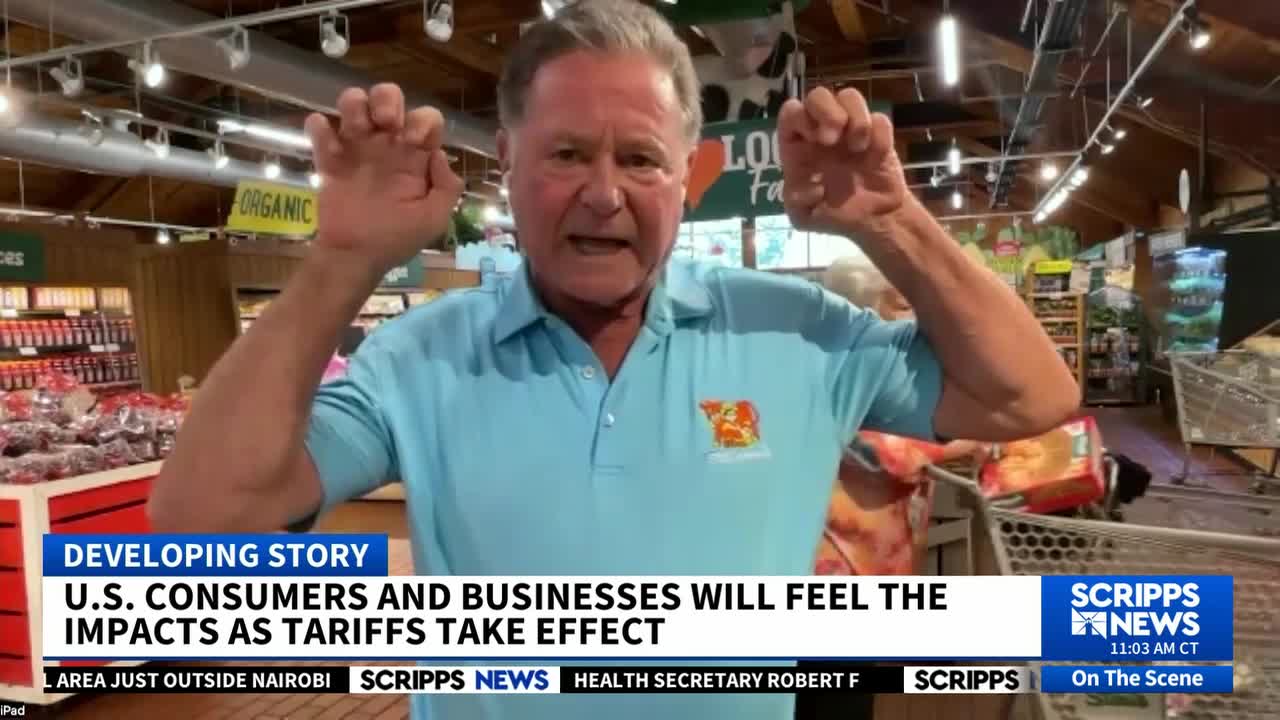Standing in the middle of one of the grocery stores his family has run for decades, President & CEO Stew Leonard Jr. is surrounded by fresh produce, dairy products and meat — most of them facing new steep increases from tariffs affecting imports, which took effect overnight Thursday. Until now, he’s been absorbing the cost of tariffs alongside producers to avoid having to pass on prices to his customers, but he says that can only last so long.
For the last several months, the U.S. has been charging a 10% tax on most of what we import. Overnight Thursday, the rate increased to 15 percent on goods from Europe, Japan, and South Korea, and even higher tariff rates are hitting trading partners like Canada, Switzerland and Brazil.
This means that typical items on Americans’ grocery lists like produce, seafood, beef, wine and spirits, and even canned food and beverages are more expensive to ship in to the U.S. — resulting in an average tax of 18.6% for imported products, the highest rate in the U.S. since 1933.
“We don’t want to raise prices, but I have 2,500 people working here right now and labor costs have gone up too,” Leonard told Scripps News, in between greeting customers shopping at his store. “We’re trying to negotiate the best deals, and we’re scrambling, trying to source product from different countries. But we’re almost hanging by a thread here and we’re getting ready to drop! Our suppliers brought a lot of product in pre-tariffs, but that’s running out.”
It’s a problem small business owners are facing across the country, as they make up 97% of U.S. importers, according to Small Business for America’s Future, a national coalition of business owners. The group drafted a letter from more than 100 small business owners addressed to President Trump and Treasury Secretary Scot Bessent, among other lawmakers, describing the new tariffs as an “immediate and severe” crisis, and calling for “tariff relief that recognizes the disproportionate burden these policies place on small businesses.”
Nearly half of businesses are currently absorbing some of the costs of the tariffs, while 14% of businesses are currently passing the full costs of the increases on to their customers, according to a new study on tariff risks in the supply chain by Creditsafe.
But for Legrand Lindor, the owner of LMI Textiles, which primarily distributes medical supplies out of Massachusetts, his previously agreed upon rates and contracts with various health departments does not allow him to increase prices.
“I tried to buy a large amount of inventory to get ahead of it, but the tariffs beat me,” Lindor told Scripps News. “So I’m going to have to sit on this product and probably make no money on it and pray that tariffs go down. We have such a strong relationship with our supplier and the product we produce with them is unique, so I can’t really do it anywhere else, unless I undercut them and start producing the stuff myself in Asia. I don’t want to do that.”
Before the tariffs, Lindor says he was exploring opening his own warehouse and hiring on more employees to work for him, but without stable income, he’s had to put that hope on pause.
RELATED STORY | Trump implements new tariffs, raising effective rate to highest since 1934
Even while large corporations often have resources to navigate supply chain disruptions or absorb unexpected cost increases, these tariffs are impacting their bottom lines and operations as well.
Procter & Gamble announced price adjustments on a quarter of their products, indicating the change in cost will go into effect in the “next few months,” citing “higher raw-material and supply chain costs, investments in product innovation and the impact of recently announced tariffs.” Meanwhile, Walmart’s CEO Doug McMillon warned of price hikes on food, toys, and electronics on the company’s earnings call Thursday.
“The merchandise that we import comes from all over the world; all the tariffs create cost pressure for us,” McMillon said on the call.
Tariffs on goods from Mexico and China are still pending as the White House continues negotiations on a trade deal, which only adds to anxiety for companies.
“There are still some ongoing negotiations and discrepancies about the deals that have been reached, leading to continued uncertainty around the final rates. There are also concerns about the impact of the different sectoral tariffs being considered and potential secondary tariffs over Russian oil,” wrote Jon Gold, National Retail Federation VP of Supply Chain and Customs Policy, in a statement. “Retailers have been able to hold the line on pricing so far, but the new increased tariffs will significantly raise costs for U.S. retailers, manufacturers and consumers. While we support better trade deals, we need to negotiate clear and binding agreements that all parties will adhere to."
With prices increasing for customers, the tariffs are expected to cost U.S. households on average $2,400 in 2025, according to new estimates from the Budget Lab at Yale University. The Lab warns shoppers should be prepared to pay more for apparel and shoes, as the combined tariffs “disproportionately affect clothing and textiles.”
If there’s a silver lining though, Leonard pointed out, it’s the drop in prices for lobster — while hoisting a live crustacean from the seafood counter onto his shoulder.
“We used to sell all our lobster to China, but with the tariffs Trump imposed, that’s gone way down and increased the supply in the U.S,” he said. “So the price of this guy has come down a little bit. It’s a bumpy road with the tariffs, but I personally hope it’ll all be worked out ahead of Thanksgiving.”




